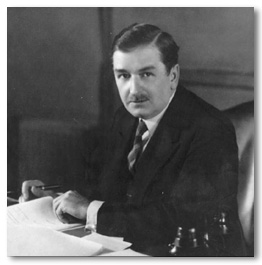Duplessis Quebec is Long Gone
- FATHER RAYMOND DE SOUZA
Priest-ridden. Not an adjective one comes across too often, but it has been near-ubiquitous in the 10 days since the Quebec election.
 |
|
Maurice Duplessis
(1890-1959) |
Much of the commentary about the remarkable rise of Mario Dumont and the Action démocratique du Québec has argued that he has refashioned the forces of Maurice Duplessis and the Union Nationale, the conservative, nationalist party that dominated Quebec politics in the 1940s and 1950s. And no comment on Quebec of that period is complete without noting that Quebec society under Duplessis was priest-ridden.
In the historiography of post-Quiet Revolution Quebec, the Duplessis period is all darkness, a time of autocratic politics in service of a repressive Catholic Church that kept les Québécois backward and poor. Indeed, the period is known as la Grande Noirceur — the Great Darkness. The death of Duplessis in 1959 was the first light of dawn, a light that would grow into the full brightness and splendour of the Quiet Revolution.
It is quite implausible that Mario Dumont wants to go back to the Duplessis days — and even if he did, the Quiet Revolution so devastated the Church that not even the parishes of Quebec are priest-ridden any more. To the contrary, the last major intervention of the bishops of Quebec in public life was to support the secularization of the Quebec schools.
Perhaps the majority of Quebec priests during la Grande Noirceur behaved badly, abusing their privileged position. I rather doubt it, but certainly there must have been many who did. And they no doubt harmed the faith and development of many people, for which they bear responsibility.
At the same time though, the Church in Quebec did manage to create a vibrant Québécois culture, including French schools, classical colleges, polytechnics, hospitals, social action groups, labour unions and several high-quality newspapers. All of this was done long before Quebecers were maîtres chez nous; after all, the intellectual vibrancy and civil institutions that led the Quiet Revolution of the 1960s emerged from the same Quebec of the supposed darkness.
The enormous scale of the Quiet Revolution and its aftermath, from the great nationalization projects to Bill 101, were all justified on the grounds of protecting the French reality in North America. Yet for the two centuries from the Plains of Abraham to the death of Duplessis that same French culture remained intact, and even thrived, without the grand coercive state action of the Quiet Revolution. Québécois culture was not invented in 1960, and if Quebec society before that was truly priest-ridden, then the priests were at least in part responsible for preserving the national project for 200 years.
All that was a long time ago though. Why then the intensity of the inveighing against the priestridden society today? One might begin by asking: Who replaced the priests? In 1960 Quebec decided it was out with the priests and in with the politicians. The sacred was replaced by the secular state. And the national project ever since has been a massively statist enterprise. It is surely not coincidental that the three leaders in the Quebec election — Jean Charest, André Boisclair, Mario Dumont — are all men who have spent their entire adult lives in politics. Charest was first elected at 26, Boisclair at 23 and Dumont at 24.
Yet today, 48 years after the death of Duplessis, the state-centred development of Quebec is showing signs of strain. Quebecers pay high taxes, have an enormous provincial debt and are dissatisfied with the quality of their public services, health care primary among them. Economically, Quebec is near the bottom of productivity and economic growth in North America. Even the sainted Lucien Bouchard has publicly spoken about the need for dramatic change — a rejection of the statist principles of the Quiet Revolution.
The defenders of the state in Quebec’s vast political class know this. Quebec will change, or if it refuses, will grow poorer and less populous (it already attracts proportionately fewer immigrants than the rest of Canada). Voters were likely attracted to the ADQ, not out of a desire for the return of the black robes, but out of frustration with a society wrapped in red tape and drowning in red ink.
So the defenders of statist Quebec fight back, raising the spectre of darkness and Duplessis, animated by more than a touch of anti-clericalism. But the priests haven’t been running Quebec for almost 50 years now. It’s long past time for Quebec’s current maîtres to answer for the crisis of the present, rather than the legends of the past.
 This is Meaghen Gonzalez, Editor of CERC. I hope you appreciated this piece. We curate these articles especially for believers like you.
This is Meaghen Gonzalez, Editor of CERC. I hope you appreciated this piece. We curate these articles especially for believers like you.
Please show your appreciation by making a $3 donation. CERC is entirely reader supported.

Acknowledgement
Father Raymond J. de Souza, "Duplessis’ Quebec is long gone." National Post, (Canada) April 5, 2007.
Reprinted with permission of the National Post and Fr. de Souza.
The Author
 Father Raymond J. de Souza is chaplain to Newman House, the Roman Catholic mission at Queen's University, Kingston, Ontario. He is the Editor-in-Chief of Convivium and a Cardus senior fellow, in addition to writing for the National Post and The Catholic Register. Father de Souza is on the advisory board of the Catholic Education Resource Center.
Father Raymond J. de Souza is chaplain to Newman House, the Roman Catholic mission at Queen's University, Kingston, Ontario. He is the Editor-in-Chief of Convivium and a Cardus senior fellow, in addition to writing for the National Post and The Catholic Register. Father de Souza is on the advisory board of the Catholic Education Resource Center.




